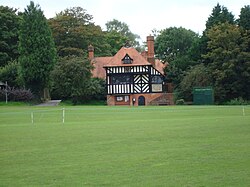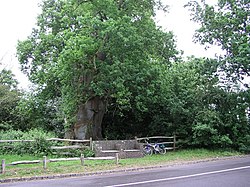Tilford
| Tilford | |
| Surrey | |
|---|---|
 Tilford Green and the Tilford Institute | |
| Location | |
| Grid reference: | SU875434 |
| Location: | 51°10’60"N, -0°44’54"W |
| Data | |
| Population: | 765 (2001) |
| Post town: | Farnham |
| Postcode: | GU10 |
| Dialling code: | 01252 |
| Local Government | |
| Council: | Waverley |
| Parliamentary constituency: |
South West Surrey |
Tilford is a small village in Surrey, about two miles south of Farnham. It lies within the Surrey Hills Area of Outstanding Natural Beauty[1]
History

The name "Tilford" is probably derived from "Tila's ford" or "Tilla's ford".[2]
Two mediæval bridges span the branches of the River Wey and are listed as ancient monuments. Several substantial farm houses date from the 16th century. Tilford House was built in 1727 and its chapel in 1776.[3]
In the mid eighteenth century the village was owned by Elizabeth Abney, daughter of Lady Mary Abney; and her detailed local survey map has survived to this day in the British Library.
Features of interest
- The village green, a triangular greensward around which the village is gathered. It is used for cricket in the summer.
- The two branches of River Wey, Wey North and Wey South, both flow through the village to a confluence nearby.
- The Barley Mow, a pub built in about 1763.[4]
- Tilford Oak
- The Tilford Institute, built in 1894 to Sir Edwin Lutyens' design and which is a focus for sport.
- All Saints Church
- South Bank Cottage (formerly Gorse Cottage) was home for 8 years from 1885 to Henry Shakspear Stephens Salt]] the writer and campaigner for social reform.
- The Rural Life Centre; a collection or artefacts and reconstructed rural buildings relating mainly to the local area. The annual Weyfest music festival takes place here.
- Bourne Woods (familiar to cinema goers; scenes from Gladiator (2000) and Robin Hood (2010) were filmed here.[5])
Tilford Oak or King's Oak or Novel's Oak

Beside the green, the Tilford Oak is said to be at least 800 years old.
William Cobbett and his son were riding through Tilford to Farnham on an autumn day in 1822 and about this he wrote about the Tilford Oak:
We veered a little to the left after we came to Tilford, at which place on the Green we stopped to look at an oak tree, which, when I was a little boy, was but a very little tree, comparatively, and which is now, take it altogether, by far the finest tree that I ever saw in my life. The stem or shaft is short; that is to say, it is short before you come to the first limbs; but it is full thirty feet round, at about eight or ten feet from the ground. Out of the stem there come not less than fifteen or sixteen limbs, many of which are from five to ten feet round, and each of which would, in fact, be considered a decent stick of timber. I am not judge enough of timber to say anything about the quantity in the whole tree, but my son stepped the ground, and, as nearly as we could judge, the diameter of the extent of the branches was upwards of ninety feet, which would make a circumference of about three hundred feet. The tree is in full growth at this moment. There is a little hole in one of the limbs; but with that exception, there appears not the smallest sign of decay.
Eric Parker wrote that this was a curious error by Cobbett:
Visitors to Tilford can amuse themselves with trying over Cobbett's measurements. I could not reach to measure it ten feet from the ground; but at five feet I made its girth, in July, 1907, twenty-four feet nine inches. Probably it was not much less when Cobbett was a little boy. That independent, combative mind would not accept another's measurements, and if he remembered the tree as a little tree, then a little tree he was right in remembering. Since his day the signs of decay have set in; the oak is still superb, but a Jubilee sapling has been planted as a neighbour. Centuries hence the sapling, perhaps, will be the King's Oak again.[6]
Parker measured the girth again in 1934 and found it to be 1 foot more:[7] The tree's branches have been lopped in recent years and the trunk is patched with iron sheets.
There are three other "British Oaks" nearby, planted at each corner of the triangular green, to commemorate the following occasions:
- 60 years of Queen Victoria's reign (1897)
- the coronation of King Edward VII (1902)
- the accession of King George V (1910) — this oak was uprooted in the 1987 storms and has been replaced.
Outside links
| ("Wikimedia Commons" has material about Tilford) |
References
- ↑ Tilford Woods
- ↑ J. E. B. Gover, A. Mawer, F. M. Stenton with A. Bonner The Place-names of Surrey English Place-Name Society Volume XI Cambridge University Press ISBN 978-0904889222 p173
- ↑ Visit Haslemere
- ↑ The History of the Barley Mow - Tilford
- ↑ Gladiator
- ↑ Eric Parker Highways and Byways in Surrey MACMILLAN First Edition, 1908 Reprinted, 1909
- ↑ Eric Parker Highways and Byways in Surrey MACMILLAN Second Edition, 1935
